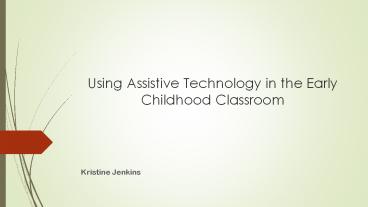AT in Early Education - PowerPoint PPT Presentation
Title:
AT in Early Education
Description:
Shows teachers how they can utilize AT with the children in their class. – PowerPoint PPT presentation
Number of Views:66
Title: AT in Early Education
1
Using Assistive Technology in the Early Childhood
Classroom
- Kristine Jenkins
2
What is Assistive Technology?
- Services
- Any service to the child with a disability,
family or educator, that helps with selection,
acquisition and use of the device.
- Devices
- Any equipment or software, purchased, modified or
created that improves the access, functionality,
understanding and participation of a child with
disabilities.
3
How is the need for AT determined?
- Observe the child in the classroom.
- Is the child having difficulty completing certain
tasks or communicating? - Discuss routines and activities with parents,
gather feedback. - What does the child do well?
4
How is the need for AT determined?
- What does the child like or dislike doing in the
class, and at home? - What do the teacher and parents want the child to
participate in? - Are these activities developmentally appropriate
for the child?
5
How much assistance does the child need?
- One of the main goals is to provide an
environment that is accessible to all children. - Encourage independence.
- Provide support, scaffold learning,
encouragement, then step back. - Observe, evaluate effectiveness, adjust, repeat.
6
Categories of AT for Young Children
- Computer Access
- Educational Aids
- Mobility Aids
- Sensory Aids
- Adapted Universally Designed Toys
- Daily Living Aids
- Communication Tools
7
Types of Assistive Technology (AT)
- No Tech
- Simple changes made to environment or equipment.
Homemade, or created. - No cost
- Low Tech
- Modest changes, more involved mechanics,
McGyver-ish changes to equipment. - Low Cost or no cost
- Medium Tech
- More complicated mechanical or software
modifications. May need expert assistance. - Modest cost
- High Tech
- Very advanced computer software, hardware, or
digital devices. Equipment purchased from
manufacturer. - High Cost
8
Adapted UD Toys Daily Living Aids
Large push button switch. Lowered, slanted
easel.
Open grip utensils
Cut out cup
Key chain zipper pull
9
Communication Skills Mobility Aids
Pediatric Walker
Microphone Amplifier
Positioning / Mobility Chair
Picture Board
Communication Board
10
Educational Aids Computer Access
Writing prompts
Variety of computer aids
Swivel stick mouse
Fine Motor Writing Aids
Flexible touch pad
11
Sensory Aids
Sensory Sit-upon
Sand Table
Oral Stimulators
Hammock swing
Scratch sniff book
12
Low Tech Assistive Technology
- Many types of no-tech or low-tech assistive
technologies are actually adaptations to a
device, to the instructional method or to the
environment. - Through creating this change or adaptation you
provide the individual more ease of use, ease of
participation or ease of access. - Some examples of adaptations may include
- Adjustable height table chairs
Non-slip seat surface - Adjustable lighting Pencil grip
- Pictures of objects/actions Variety of
textures
13
How does AT support inclusion?
- Technology can provide a bridge for students to
Communicate, Participate, and Learn along with
their typically developing peers. - Communicate Through augmentative and alternative
communication (AAC) devices and methods. - Participate Through inclusive playtime.
- Learn Through adapted
- curriculum and materials.
14
Making it happen in your class
- Observe, communicate
- Is there a need?
- Can you create a way to meet the need?
- Does it help the child participate?
- Do you need information or help?
- Resources
- Implementation
- Observe, communicate, adjust, repeat
15
Resources
- Assistivetech.net - www.assistivetech.net
- Center for Early Literacy Learning -
www.earlyliteracylearning.org - Family Center on Technology and Disability (FCTD)
www.fctd.info - SC Assistive Technology Program -
www.sc.edu/scatp/index.htm - Division for Early Childhood Special Needs -
http//www.dec-sped.org/
- National Assistive Technology Technology
Assistance Partnership (NATTAP) -
http//resnaprojects.org/nattap/ - Tots-n-Tech http//tnt.asu.edu
- Frank Porter Graham Institute -http//community.fp
g.unc.edu/































